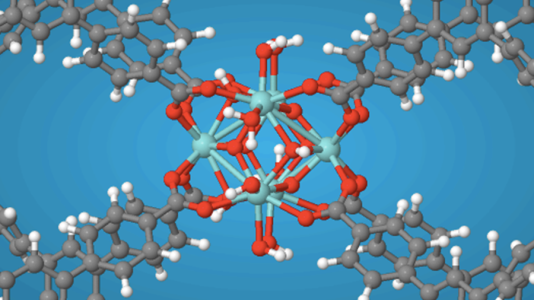Research collaboration between UChicago and Argonne boosts development of sustainable technology
Machine learning program could speed up development of novel catalysts promoting decarbonization

Solving some of the most pressing environmental problems — including water scarcity and climate change — could lie in new materials designed to collect water from air or power new energy sources.
A collaboration between the University of Chicago and the U.S. Department of Energy’s (DOE) Argonne National Laboratory has combined theory, experimentation and artificial intelligence to optimize catalysts for materials called metal-organic frameworks (MOFs). With a molecular structure that gives them a porous internal surface area, MOFs can be functionalized to act like sponges with high adsorption power — allowing them to house gas, collect water from air or even enhance chemical reactions.
Working with Professor Laura Gagliardi, UChicago graduate student Daniel King collaborated with the group of Max Delferro at Argonne to develop a better method for finding novel MOF catalysts, which have the potential to speed up industrially relevant chemical reactions.
“Increasing the efficiency of catalysts is critical for developing sustainable solutions and promoting decarbonization.” — UChicago graduate student Daniel King
The group used machine learning algorithms combined with high-throughput experimentation to screen different metals, temperatures and pressures applied to the MOF NU-1000 for catalytic activity.
After 2,000 reactions, the collaboration used this process to ultimately improve the yield of these chemical reactions from 0.4% to 24.4%.
“This is really to show best practices for high-throughput experimentation research,” King said. “It’s important to use machine learning algorithms to guide these experiments, but they aren’t automatic. They still need human input to be successful.” The results were published in ACS Central Science.
King received funding to work at Argonne and collaborate closely with the scientists and engineers there, which he said was a learning experience that was ultimately key to the success of the research. “It was a direct collaboration between theory and experiment,” King said. “Often theorists are called upon to explain results, but in this case, I had an active role in designing the how the experiment would go.”
The researchers involved are members of the Catalyst Design for Decarbonization Center, funded by the DOE as part of its Energy Frontier Research Center program. The center’s mission is to discover new catalysts for the decarbonization energy transition and to optimize the key catalytic reactions involved.
“Increasing the efficiency of catalysts is critical for developing sustainable solutions and promoting decarbonization,” King said. “Understanding how to find the best catalysts for reactions is an important step in that direction.”
This release was originally posted by UChicago.
Argonne National Laboratory seeks solutions to pressing national problems in science and technology by conducting leading-edge basic and applied research in virtually every scientific discipline. Argonne is managed by UChicago Argonne, LLC for the U.S. Department of Energy’s Office of Science.
The U.S. Department of Energy’s Office of Science is the single largest supporter of basic research in the physical sciences in the United States and is working to address some of the most pressing challenges of our time. For more information, visit https://energy.gov/science.